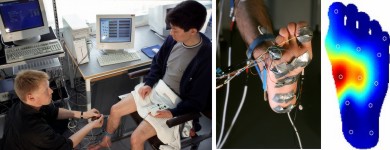Assessment of Spinal Nociception Laboratory
Head of Laboratory: Ole Kæseler Andersen, Professor (OKA)
Aim
The aim of the lab is to assess and modulate spinal nociception in humans. The nociceptive withdrawal reflex is investigated in detail for understanding reflex pathways, reflex modulation, and as a biomarker for probing spinal nociception. Surrogate models for spinal sensitisation are developed.

Assessment of the organisation of nociceptive withdrawal reflexes in the lower limb involve several stimulation sites on the sole of the foot. Typical reflex size distribution for the tibialis anterior muscle is depicted on the right.
Main Research Areas
- The nociceptive withdrawal reflex - Probing spinal nociception
The spinal organization of withdrawal reflexes receives substantial attention in the lab. Methods for quantifying the reflex receptive field (RRF) are constantly in focus. The RRF technique is utilized to study spinal nociceptive processing in models of central sensitization and in patients. The influence of descending control is evaluated, e.g. by studying reflexes in spinal cord injured volunteers. - Models of cutaneous hyperalgesia and Long Term Potentiation (LTP):
New models are developed and sensory characteristics of existing models are evaluated. Both sensory and vascular measures are assessed by state-of-the art cutaneous stimulators and imaging techniques for evaluating peripheral and central mechanisms.
Key Collaborators
- Nanna Finnerup, Astrid Terkelsen, and Troels Staehelin Jensen, Danish Pain Research Center, Aarhus University Hospital, Aarhus, Denmark.
- Michele Curatolo, Division of Pain Therapy, Department of Anesthesiology, University Hospital of Bern, Inselspital, Switzerland.
- Claudia Spadavecchia and Alessandra Bergadano, Department of Clinical Veterinary Medicine, Anaesthesiology Division, Vetsuisse-Faculty, University of Berne, Switzerland.
- Oliver Wilder-Smith, Pain Centre, Department of Anaesthesiology, University Medical Centre St. Radboud, Nijmegen, The Netherlands
- Thomas B. Moeslund, Department of Architecture, Design and Media Technology Aalborg University, Denmark
